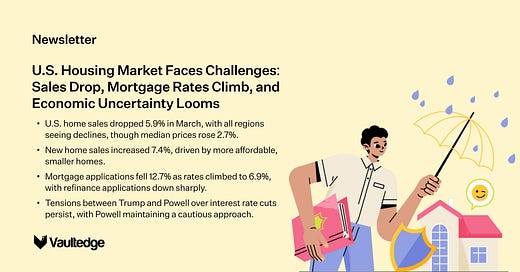U.S. Housing Market Faces Challenges: Sales Drop, Mortgage Rates Climb, and Economic Uncertainty Looms
Your Weekly Briefing: Housing Market Declines, Mortgage Rate Pressures, and Economic Uncertainty Shape the Landscape
What's Included:
U.S. home sales dropped 5.9% in March, with all regions seeing declines, though median prices rose 2.7%.
New home sales increased 7.4%, driven by more affordable, smaller homes.
Mortgage applications fell 12.7% as rates climbed to 6.9%, with refinance applications down sharply.
Tensions between Trump and Powell over interest rate cuts persist, with Powell maintaining a cautious approach.
Here’s a complete low-down 👇
Before you move on …
We would love, if you could subscribe to our newsletter.
Housing Market Slows as Home Sales Drop 5.9% in March
U.S. home sales dropped 5.9% in March, reaching an annual pace of just 4.02 million—below levels seen during the height of COVID-19. According to the National Association of Realtors, persistently high mortgage rates and ongoing economic uncertainty continue to weigh heavily on buyer sentiment. All regions experienced a monthly decline, with the Midwest and Northeast also showing year-over-year dips.
Despite the slowdown, the median home price rose 2.7% from last year to $403,700, marking the 21st consecutive month of price increases. Lawrence Yun, NAR’s Chief Economist, attributed the sluggish activity to affordability challenges, warning that record-low housing mobility may signal broader concerns for economic mobility as well.
In contrast, new home sales increased by 7.4% in March, buoyed by a shift toward smaller, more affordable homes. Builders are adapting, offering lower prices that attract budget-conscious buyers. But analysts caution that the overall housing market could face further headwinds. With inflation fears, looming tariffs, and a cautious consumer outlook, economists like Robert Frick warn that “March numbers are bad, but they’re likely to get worse.” As financial pressures mount, many families may continue to hold off on buying or moving…. Read More.
When Will Mortgage Rates Go Down—and Why Waiting Might Not Be Worth It in Today’s Unsteady Economy
Mortgage rates have remained stubbornly high in 2025, with 30-year fixed rates hovering around 6.8%. While this is a slight improvement from last year’s 7.17%, it’s still a far cry from the sub-3% rates seen during the pandemic. Despite hopes for relief, the Federal Reserve's cautious stance and sticky inflation suggest that rates are likely to hold steady through the rest of the year.
So, should you wait to buy? Experts say no. With limited housing supply and steady demand, home prices remain elevated. If mortgage rates dip during a recession, more buyers will flood the market, further driving up prices. A better strategy may be to buy within your means now — whether that means exploring condos, longer commutes, or fixer-uppers — and consider refinancing later if rates improve.
Ultimately, homeownership in today’s market requires a shift in mindset. Instead of waiting for the “perfect” rate, focus on building equity in a home you can afford today. With the right planning and a creative approach, owning a home is still within reach — even in an unsteady economy….. Read More.
Rates Reach 6.9% — Mortgage Applications Drop 12.7% Amid Market Uncertainty
Mortgage activity slowed sharply last week as interest rates climbed to their highest level in two months, according to the latest MBA survey. The Market Composite Index fell 12.7% on a seasonally adjusted basis, with refinance applications plunging 20% and purchase applications slipping 7%. Despite the weekly dip, purchase activity remained 6% higher than the same week last year, signaling some year-over-year resilience.
Joel Kan, MBA’s Deputy Chief Economist, noted that the 30-year fixed mortgage rate rose to 6.9%, up nearly 30 basis points over two weeks. This rate spike significantly impacted refinances, especially for larger loan amounts, driving the average loan size lower. The refinance share of mortgage applications fell to 37.3%, its lowest level since January. Economic uncertainty and rate volatility also contributed to the dip in homebuyer demand.
Loan type distribution showed small shifts: FHA applications rose to 16.7%, VA loans dipped to 13.4%, and ARMs decreased to 7.5%. While mortgage professionals continue to navigate this volatile rate environment, the data suggests that high borrowing costs will remain a hurdle for both refinancers and buyers in the months ahead….Read More.
Trump vs. Powell: The Battle Over Interest Rate Cuts Continues
The ongoing back-and-forth between President Donald J. Trump and Federal Reserve Chairman Jerome Powell over interest rate cuts shows no signs of slowing. On April 17, President Trump took to Truth Social to criticize Powell for not following the European Central Bank’s lead in cutting rates, dubbing the Fed Chair “Too Late” and calling his latest economic report a “complete mess.” The President’s frustration, fueled by the ECB’s three rate cuts this year, culminated in calls for Powell’s termination, highlighting Trump’s growing impatience with the Fed’s cautious approach.
Powell, meanwhile, has maintained that the U.S. economy remains resilient, with inflation easing and the labor market near maximum employment. Speaking at the Economic Club of Chicago, Powell humorously invoked Ferris Bueller, noting that “life moves pretty fast,” but stressed the importance of waiting for greater economic clarity before making any policy changes. While hinting at possible rate cuts in 2025, Powell emphasized that the Fed must navigate evolving trade policies, tariffs, and regulatory shifts from the Trump Administration before adjusting its stance.
As economic uncertainty lingers and market volatility continues, analysts speculate that rate cuts could still be on the horizon should conditions worsen. For now, however, Powell remains steadfast in his “watch and wait” approach, even as the tug-of-war with the White House intensifies….Read More.
That’s a wrap for this week’s edition. Stay informed on the latest trends in the housing market, mortgage rates, and economic uncertainties. Subscribe now to stay ahead of the curve in the ever-evolving mortgage industry—all in one place.




